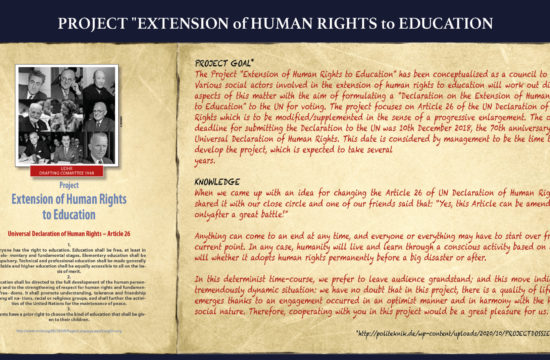Lecturer, Kenyatta University, Department of Early Childhood & Special Needs Education – KENYA
The author uses narrative inquiry to convey her individual experiences on children with disabilities who beg in the streets of Nairobi, with the aim of readers gaining a consideration of this socially shared understanding and to unfold dimensions of subjective otherness.
In the streets, alleys, pavements, roadsides, pedestrian walks, fronts of shops, sidewalks, dusty path walks and highways in slow traffic, are business ‚premises‘ of very exceptional
traders, yes inimitable; children with disabilities (CWDs). These children are visible on their wheelchairs, clutches, calipers and boots, boules and shabby polythene spreads (despite
a ban on plastics in Kenya) and, occasionally, threadbare umbrellas. They are usually clad in tattered dirty clothes that barely cover their bodies and are accompanied by hurriedly written placards displaying their names; form and cause of disability; and reason for begging from either pedestrians or cyclists and even motorists (never mind the dirty and tattered paper the message is scribbled on). The places chosen for their trade are usually positions accessible to substantial human and vehicular traffic.
These children are usually tired, weary, dressed in pitiful faces, hungry, angry and sometimes clad with demeaning faces. Nonetheless, what stands out the most about these children is the spectacle of their intentionally exposed body parts and in particular those with profound physical disabilities. The body parts of the children usually exposed are in forms of: amputations (fingers, hands, arms, toes, legs etc.), fractured body parts, spinal cord injuries, hydro-cephalous, down syndrome, cerebral palsy, spina-bifida, muscular-dystrophy, severe burns, scars from major surgeries and dwarfisms. Other categories of children seen in the streets are those with; visual impairments and communication difficulties. A majority of these children’s conditions are characterized by long term physical conditions that pose problems in their movement of muscles and exercising of their motor control. Some suffer from involuntary spasms, visual impairment and even paralysis, leaving many children bound on wheelchairs. A majority also suffer from ineffective verbal and non-verbal skills and motor conditions that hamper their development and movement to an extent (Andrade, 2018).
These children are present in the aforementioned ‚business premises‘ as early as 5 am; so then, how do children with conditions as those mentioned above, get to the sites at such
an early hour? Research (Namwata, Mgabo & Dimoso, 2012) reveals that these children have families and are dropped and picked daily by either a parent, sibling, relative or guardians, or by a third party. This enables the children to secure their sites daily for the purpose of collecting alms from passersby. Furthermore, the children are exposed all day to punitive conditions that may be windy, cold, wet, rainy, dry, sunny, cloudy and dusty. Additionally, they experience untold hunger pangs, thirst and no toilet to relieve them.
After the caregivers drop them, the children either stretch out their stronger palm out or faintly shout out ’nipe nipe‘ meaning “give me, give me” in English. On lucky days, the children receive few pieces of silver and occasionally higher currency, and then quickly the child will remove the alms and hide away from passersby. This secret place where they hide their
alms may be either the wheelchair or their inner clothes, thus leaving the bowl perpetually empty. This means that, there is no moment at which the bowl is found with ‘valuable’ alms except when it is given. This strategy is termed as a streetwise skill of crafting empathy. The child performs this act from the crack of dawn to late evening every day, with no rest, after which the ritual of picking them up takes place. Hurriedly, at or soon after dark catches on, the caregivers will promptly return to first collect the day’s alms from the ‚family bread winner‘ and then to return the child home. And the ritual is repeated as the alms given fortify the business.
The children beggars are said to be from destitute families from little earnings expanses at the periphery of the city whose families are largely engaged in unskilled occupations or with no revenue and live below the poverty line. Begging concerning children is a significant living choice for existence in developing countries (Hawkson, 2015). The occurrence is a multifaceted and complicated encounter to deal with because of the nature and because it involves children who are relatively fragile to endure the high level of susceptibilities. Majority
of the city dwellers give the impression to be in complicity and considerate to the vice.
Forced begging among CWDs is a global menace and, in particular, in Sub-Sahara, Africa. Child labor impinges on the fundamental human rights of the child. The trade-off that occurs between the children’s care, protection and schooling for child labor; interrupts time spent in school and reduces educational success. The being of CWDs begging in Kenya is equally an ancient occurrence, yet the part of cutting the incidence is minimal or largely absent. Occasionally, there have been state measures to curb the rising occurrences in the city but they have largely been ineffective. From time to time, the state machinery rounds them up in impromptu street raids and reluctantly, holds them up them in state institutions; an act that is often condemned by the citizenry.
Forcing children with disabilities to beg is referred to as child labor and is one of the worst forms of child labor (Save the Children, 2012). Homelessness, Beggars and Destitute Persons Act, 1977, the content of which did not depart from the 1963 decree, educed the state’s locus on begging. Under the Act, begging is a criminal act in Kenya and lawbreakers are to be prosecuted. Likewise, under the Children’s Act of 2001, the Persons with Disability Act, 2003 and the Constitution of Kenya, 2010; child labor is illegal in Kenya and children are entitled to be protected from social and economic exploitation and should not be employed in or required to perform work that is likely to be hazardous or to interfere in their education, or to be harmful to their health or physical, mental, spiritual, moral or social development. In the
face of the state’s legal position on child labor, studies indicate increase in the vice (Kahongeh. 2018).
Thus, this article strongly condemns forcing CWDs to beg for alms because it is an offensive act that discriminates and stigmatizes the children. It additionally absents them from schooling and learning, exposes them to grave health risks, and thwarts their social and economic protection initiatives, thus bearing contrary long-lasting effects on the future of the children. This correlates with ILO, 2008 who lay down that schooling and child labor are discordant and have established an adverse correlation between child labor and educational attainment. It is with this in cognizance, that the author concludes the article that all actions concerning children shall be guided by the principle of their best interests. In this case, it may involve but is not limited to: empowering families and communities to protect their own, creating state and public awareness, mobilizing support, disseminating information and ideas leading to workable action to restore the children’s rights (UNHCR, 2011).
Reference
• Andrade, M. M. (2018) Characteristics of students with physical disabilities from their teachers’ perceptions: a study on the conceptual parameters of the international classification of functioning, disability and health. View at https://doi.org/10.1590/s1413-65382418000100002
• Hawkson, E. E., (2015). Trained beggars with parents as teachers. Access at https://www.graphic.com.gh/features/features/trained-beggars-with-parents-asteachers.html
• ILO, (2008). Report of the meeting of experts on labor statistics. Access at https://www.ilo.org/global/standards/information-resources-and-publications/publications/
WCMS_086223/lang–en/index.htm
• Kahongeh, J, (2018) Behold the shame of a society that has neglected its children. Access at https://www.nation.co.ke/kenya/life-and-style/dn2/beholdthe-shame-of-a-society-that-has-neglected-itschildren-
2784
• Kassah, K. A (2008) Begging as work: A study of people with mobility difficulties in Accra, Ghana,” Disability & Society, vol. 23, no. 2, pp. 163–170, 2008.View at: Publisher Site
• Namwata, B. L. , Mgabo, M. R. and Dimoso P., (2012) Categories of street beggars and factors influencing street begging in Central Tanzania, African Study Monographs, vol. 33, no. 2, pp. 133–143.
• Save the Children (2011) Regional report on child begging: prevalence, prevention and suppression of child begging, South East Asia: Safe the Children.
• UNHCR (2011) Field handbook for the implementation of UNHCR bid guidelines. Accessed at https://www.refworld.org/pdfid/4e4a57d02.pdf











